
Bezos, a seriously ambitious individual who also founded the now-gargantuan Amazon, is planning to launch the first sub-orbital rides for tourists aboard the New Shepard rocket as early as next year.
The cost of a ticket is currently unknown, though we imagine that for most wannabe travelers, securing the funds for the trip may involve shenanigans of the illegal variety or extremely good luck in the lottery. But there will soon be a much easier way to experience a ride on Blue Origin’s New Shepard rocket. Sort of.
It will mean heading to the EAA AirVenture event in Oshkosh, Wisconsin, from July 24-30, and seeking out the Blue Origin exhibit.
Beside a New Shepard rocket, you’ll also find a full-size mockup of the astronaut crew capsule that forms part of Blue Origin’s reusable rocket system.
It holds six people, and visitors will have a chance to climb aboard, sit back in one of the comfy seats, and experience a simulated trip to space thanks to footage shot during previous missions by the New Shepard’s onboard cameras.
Going to Oshkosh? Come sit inside @BlueOrigin’s crew capsule and enjoy a simulated ride to space @EAA #OSH17 https://t.co/E6uejQLDgG pic.twitter.com/EjUuY5bdw7
— Jeff Bezos (@JeffBezos) July 10, 2017
The crew capsule, which is yet to be tested by humans during an actual Blue Origin mission, features the largest windows “in spaceflight history,” according to the company. This means that every space tourist and astronaut — as well as everyone on the simulated ride — will be able to marvel at the awesome view outside as the spacecraft heads toward space, and back again.
“We are very excited to come to EAA AirVenture Oshkosh 2017 and showcase our reusable New Shepard rocket and crew capsule so everyone can experience what it’s like to be an astronaut,” said Blue Origin president Rob Meyerson. “We hope to inspire the explorers of tomorrow, the ones who will help us achieve Blue Origin’s goal of millions of people living and working in space.”
Bezos and his Blue Origin team nailed their first rocket landing back in 2015, with four more achieved since then. They also beat SpaceX to become the first to reuse a rocket, landing one for the second time last year. The team has been working to perfect its reusable system, which includes the all-important crew capsule that will one day carry tourists and astronauts spaceward.
While the Oshkosh experience will involve everyone remaining well and truly on terra firma, future space tourists will be able to enjoy a trip 62 miles above Earth to experience “life-changing views of our blue planet.” They’ll even be able to release their harness and experience the freedom of weightlessness during what is certain to be a spectacular 11-minute ride of a lifetime.
Editors' Recommendations
- Blue Origin’s heavy-lift New Glenn rocket raised on launchpad for first time
- See how Blue Origin’s rocket did in first flight since 2022 explosion
- Jeff Bezos’ Blue Origin to make first rocket flight since 2022 explosion
- Blue Origin suffers setback as one of its rocket engines explodes during test
- Blue Origin wants to launch rockets from new site outside U.S.


